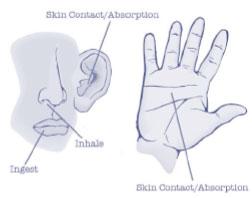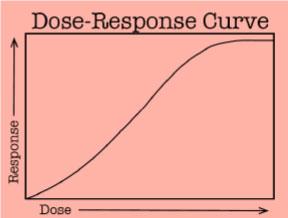Environmental Toxicology: Background
Everything in the environment is made out of chemicals. These chemicals can either be naturally occurring or synthetic. Both types can be toxic to living organisms; thus natural chemicals can also cause negative effects. Just because they are “natural,” does not mean that they are safe.
People often have a misconception about chemicals. Frequently, they only think about synthetic, toxic compounds. It is important to highlight that we use chemicals in our everyday lives, from the time we wakeup until the time we fall asleep. For example, toothpaste contains fluoride, sodium lauryl sulfate, calcium phosphate, strontium chloride, and hydrogen peroxide just to name a few. Consequently, we come into contact with these substances while brushing our teeth.
Living organisms are generally exposed to more than one chemical substance at a time (chemical interactions). These combinations cause different effects than those that would result from exposure to one single substance. Chemical interactions are important when determining health effects from exposure. Yet, their consequences are largely unknown.
Toxicology deals with natural or synthetic chemical substances in relation to the production of abnormal or undesirable results. It focuses on the symptoms, methods, remedies, and detection of a poisoning. The field of environmental toxicology studies the consequences of industrial and agricultural chemical substances on human health and the environment.
Toxicity is the quantity to which a substance can have a negative result. In the field of toxicology, the term “exposure” is discussed quite a bit. It can be defined as the act of being in contact with something and its availability to be taken into the body. Potential environmental exposures include contaminated water, polluted air, household products, garden soil, and industrial waste. The effects that result from the exposure to a toxic substance are categorized as chronic (long-term exposure and the effects take time to develop) or acute (short-term exposure and the effects occur quickly). The amount, the duration, and the type of exposure will determine the toxic outcome.
env-tox background 1.jpg

In order for a chemical substance to have any effect, it must first enter the body. Living organisms can ingest them, inhale them, or absorb them through their skin (Figure 1). They may also travel inside the body via mucous in the nose, eye, or ear canals. These pathways are termed routes of exposure.
Absorption is the mechanism by which a substance passes through and enters the body. Yet, before it is absorbed, the substance must be available to be transported and processed by the body. Bioavailability describes the extent to which a chemical can be absorbed by the organism’s system. For example, in order for salt to increase blood pressure in the body, it must be ingested orally in large quantities. If a large quantity of salt is poured onto the skin, it cannot readily travel inside to cause an increase in blood pressure.
After the chemical substance is absorbed, it is distributed throughout the body. Typically, it is distributed from the bloodstream to cells or a particular storage site(s). A storage site might or might not be where the toxicity occurs. Sometimes, it may be used as a protective barrier since the substance is not freely moving. The absorbed substance can also undergo metabolic changes (biotransformation) at the site. Finally, the substance is passed outside of the body (excretion) via such means as sweat, tears, saliva, milk, bile, and feces.
The toxic effects that manifest from the chemical depend on the way it got into the body. As well, the amount (dose) that is actually absorbed into the body (Table 1). Paracelsus, the Father of Modern Toxicology, said, “the dose makes the poison.” In other words, the consequences of a substance increase as the amount of that substance also increases. Scientists plot the relationship between the toxicant dose and the health effects on a dose-response curve (Figure 2).
env-tox- background fig-2.jpg

In addition, a chemical can produce harmful effects to one living organism while not harming another (selective toxicology). For example, an antibiotic may kill strep throat bacteria, but it will not kill you. People can also respond to chemical substances in different ways. Some may be exposed and may not develop a negative effect, while others may be more sensitive to a chemical and can develop negative effects from an exposure. No two individuals are the same; therefore the response to a dose varies considering age, lifestyle, and genetics (biological variation). Yet, if there is no exposure to a chemical, there will not be an effect.
When an organism is exposed to a toxic substance, it follows toxicity phases. The first phase is the exposure phase, which is when a toxicant is taken up by the organism’s system via the mouth (oral), lungs (inhalation), or skin (dermal). Next is the processing phase, where the toxicant is transported and stored inside the body. The rate at how it is processed varies from person to person. Lastly, the expression phase describes the resulting effects that appear in the organism (e.g. lesion or headache). Different substances result in different symptoms.
Toxicants change the function of cells in an organism by interfering with normal processes. The reaction of an organism to a toxic substance is called the response. Within toxicology, the response is measured by the changes that occur. For instance, changes may range from minor (e.g. headaches) to severe (e.g. convulsions) to adverse effects (e.g. death) (Table 1). The target tissue is the location in the body where a chemical causes adverse effects. This location can be an entire organ, a tissue, a cell, or genes. An example of this is when genetic material changes (mutation) due to the effects of a toxic substance.
| substance | toxic dose |
|---|---|
| Alcohol | An adult weighing 100 pounds who quickly consumes 9 or 10 standard drinks in less than one hour. |
| Salt | An adult man weighing 220 pounds would need to consume 300 grams of salt. |
| Pesticide (DDT) | A cat weighting 5 kilogram would need to eat 60,000 cockroaches with DDT residue in one day. |
| Toxic Chemical (Dioxin) | An adult weighing 150 pounds would need to ingest .07 milligrams. |
| Botulinum (Botox®) | An adult weighing 154 pounds would need 3,000 units (Botox® injections of 20 - 70 units per treatment are generally used for cosmetic purposes). |
Determining the risk of exposure to a chemical substance is invaluable to toxicologists. The process that is used to estimate this is called risk assessment. Risk assessment is an analysis that uses mathematical equations and scientific information (e.g. health and environmental) to determine the probability of an event occurring and the magnitude of the adverse effect over a specific time. It is used by governmental agencies to determine the unacceptable level of a chemical substance, the risk of exposure to a population at a contaminated site, and the appropriate cleanup method to safeguard human health. The risk assessment process consists of four basic steps, which are the following:
- Hazard Identification – what are the health risks caused by the chemical substance?
- Exposure Assessment – what is the amount of the chemicals substance and how many people are exposed to it?
- Dose-Response Evaluation – what are the health problems associated with the exposure?
- Risk Characterization – what are the health risks caused by the chemical substance in the exposed population?

